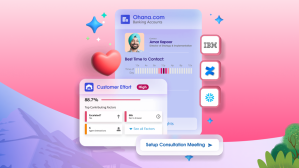Clement Tussiot is a Senior Director of Product Management for Salesforce Service Cloud. Born in Paris, he now lives in San Francisco, where he works on tools for leveraging artificial intelligence and machine learning to improve customer service. Tussiot describes himself as a customer experience nerd, a robots nerd, and a craft beer nerd. He recommends connecting the first two, then relaxing with the third. We caught up with him to discuss the future of bots.
Why do companies need bots?
Historically companies didn’t want their customers contacting the contact center. It was a cost, and usually meant there was a problem. Now, the interactions a company has with customers can make the difference in continued sales, as well as set them apart from the competition. So companies want to hear from customers. But contact centers have a hard time dealing with the sheer number of people reaching out, and the fact that customers today simply demand more. Bots can help deal with the scale problem, handling the more routine issues and making handoffs to humans when their finite capabilities are exceeded.
For example, you can use bots to directly handle simple requests like flight updates or checking on orders. For more complex interactions, where bots are out of their depth, they can still kick off the conversation and collect information (reason for contacting us, name, address, etc.) then route them to the most appropriate agent.
How can companies use artificial intelligence in service?
Three main ways. You can use it to enhance self-service for immediate, instant customer service. You can use it to empower agents to find the right solution to a problem efficiently. And you can use it to bring visibility into what’s happening in the contact center so agents are more productive on the back end. In all of these cases, natural language processing capabilities scan the text of the questions the customers are asking and, from that, determine exactly what information to serve up to them. And, on an ongoing basis, machine learning capabilities empower the artificial intelligence to improve over time. Yes, it might get an answer wrong at times, but will become less and less likely to do so over time.
What makes Einstein customer service bots different?
Einstein bots are connected directly to the biggest CRM in the world, funneling all the customer data in and making the bots smarter. We’re not building this from scratch. We’re simply plugging it in for our customers. Lots of companies have prepackaged bots that claim to understand hundreds of topics right away but they don’t have the data required to understand the customer context and provide intelligent interactions.
How does the bot learn to get better over time?
You need to start from a solid base of training data. You have to do manual research on past interactions between agents and customers so the bot knows what to expect. You have to find as many variations of the same conversation as possible in order to train the bot. Then, once the bot is deployed, it learns by enabling agents and customers to provide feedback in real time for every interaction. That feedback loop will allow the bot to learn which responses work, and then use that data to improve its algorithm.
What are some challenges companies face with bots?
It’s important to set expectations. AI-powered bots can’t solve everything on day one. It’s not a silver bullet. It’s very important to figure out what you hope to achieve, to start with limited use cases, and to never put customer satisfaction at risk.
How should humans partner with the bots?
Companies should establish fail-safe mechanisms. Make sure that when the bot doesn’t understand a customer you can bring a human into the loop to fulfill the customer request. It’s a false assumption to assume the bot can do everything. And you should be transparent. Make sure customers understand when they’re interacting with a bot or human. This will build trust with customers and perhaps give you the necessary leeway to work through kinks.




















